Activity Report
Report on Activities from April 2014 to March 2015
Big Step Towards Restoring Riparian Forest
Project to Restore Japanese Judas Trees and Life-Giving River
Judas Tree Seedlings Planted Along the Iwaobetsu River
In order to revive the former forests along the Iwaobetsu River, over the past three years we have set up a fence to prevent the Sika deer from eating seedlings and have carefully raised Judas tree seedlings in seedling fields. In May 2014, we finally planted 177 Judas tree seedlings inside the fenced area, thus achieving our target of raising and then planting the seedlings in the riparian area.
There was little rain during June and July, so we had to water the seedlings once or twice a week. Rain fell regularly from August, and we confirmed the seedlings were growing well. While the winter saw record snowfalls, there were no signs that the Sika deer had gotten over the fence.
We decided to put up another fence, and in 2014 a group of volunteers that included Daikin employees completed the erection of a 200-meter-long fence.
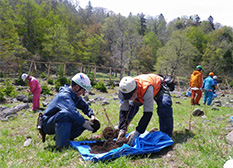 Volunteers helped out in the planting of
seedlings
Volunteers helped out in the planting of
seedlings
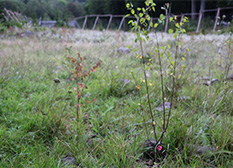 The seedlings in September: the
branches and leaves have really grown
The seedlings in September: the
branches and leaves have really grown
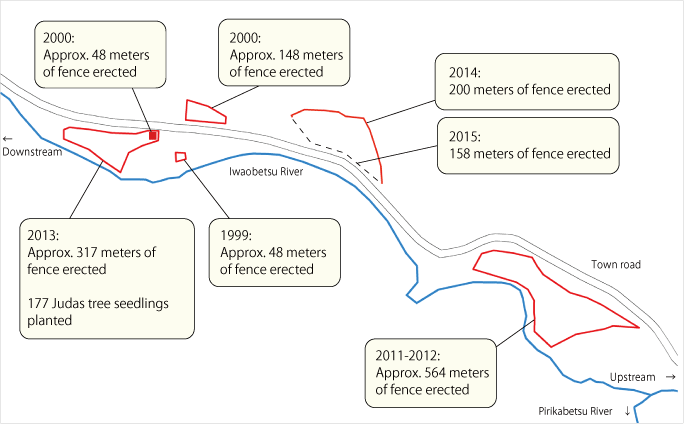 Deer Fence Erected Near Iwaobetsu River
Deer Fence Erected Near Iwaobetsu River
Artificial Banks Removed to Allow River to Flow Freely
River banks that were constructed years ago to protect the road running along the river not only narrowed the river channel but also got in the way of the river’s natural flow. To allow the Iwaobetsu River to return to its original state, in July 2014 the artificial banks were removed.
The water is now flowing where artificial banks used to prevent it, the river forks into two directions downstream, and it is gradually returning to its natural flow.

Ecosystem Survey Results Reported and Discussed by Experts
To help bring the forests and rivers back to their original natural splendor, we conducted a survey of the wildlife around the Iwaobetsu River in order to fully understand the state of the forests. We shared the survey results at a meeting in February 2015, after which people with a vested interest in the survey exchanged opinions.
For example, the survey revealed the existence of tens of thousands of fish in the river, including salt water trout (mountain trout). We also found that the upstream, above the dam that blocked the fishes’ passage, was an ideal environment for the fish to live. In the course of time, removing the dam would allow the fish to move up and down the river and give them an ideal environment.
 Participants exchanged a range of
opinions after hearing the survey results
Participants exchanged a range of
opinions after hearing the survey resultsProject to Promote Human-Brown Bear Coexistence in Shiretoko
Electric Fence Repaired and New Section Completed
The electric fences work to prevent brown bears from entering the residential area when they are not hibernating.
During 2014, the electric fence was operating fine until July, but in August torrential rains caused mudslides in multiple locations in Rausu Town. Some roads had to be closed, mudslides knocked down the power lines of the fence, and solar panels that supply power to the fence were buried under mud and carried away by rising water levels in the river. Repairs were gradually carried out and before the end of August power in the fence was back on.
In December, work installing a new electric fence began on the north side of Rausu Town. Work proceeded smoothly and the fence was completed by late January when the snow is the deepest. The fence was turned on in the spring.
A total of four motion sensor cameras, two in each of two districts, were installed to survey the effect that the electric fence is having on animals living in the forest.
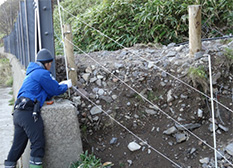 Power lines of the electric fence that
were knocked down by mudslides were strung up again
Power lines of the electric fence that
were knocked down by mudslides were strung up again Bear Baby Boom in 2014. Survey Reveals Blood Relations of Cubs and Their Parents
After testing the brown bears for DNA and surveying their movement patterns by GPS, it was determined that more than 10 bears reside permanently in the Rusha district on the west side of the Shiretoko Peninsula. In the spring of 2014, we were surprised to learn that seven of the female bears gave birth to a total of 16 cubs. It is normal for a female brown bear to have one or two cubs, but several of them were discovered with three of their own cubs. We are anxious to observe the bears to learn what the movement of these cubs will be.
Thanks to a DNA analysis performed by the Wild Animal Laboratory, Graduate School of Veterinary Medicine, Hokkaido University, we know which bears are the parents of which cubs. There are very few regions in the world where this much is known about the blood relations of brown bears.
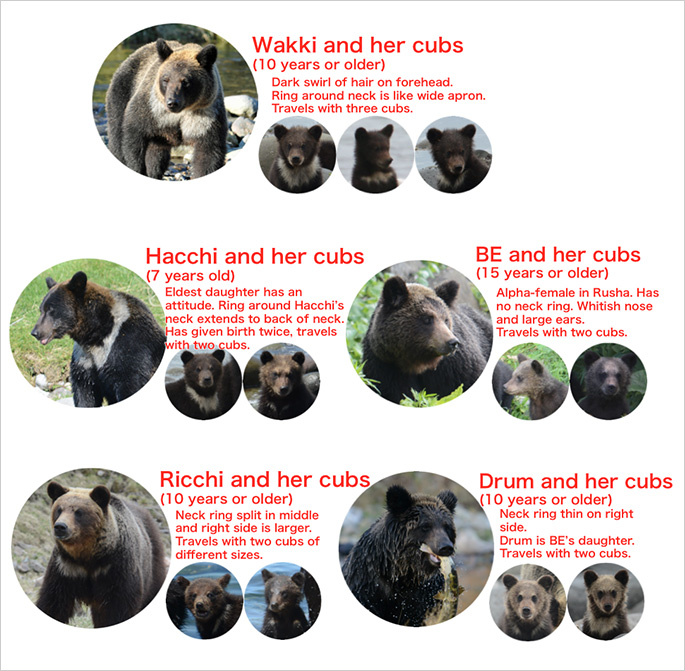 Most frequently seen five female brown bears and
their cubs
Most frequently seen five female brown bears and
their cubs
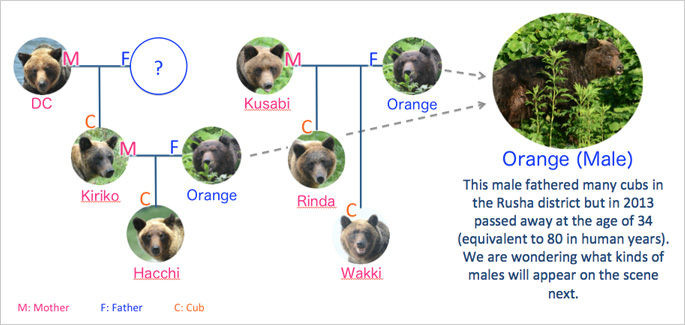 Family tree of brown bears
Family tree of brown bears
Note: The photos on this website are courtesy of the Shiretoko Nature Foundation.








